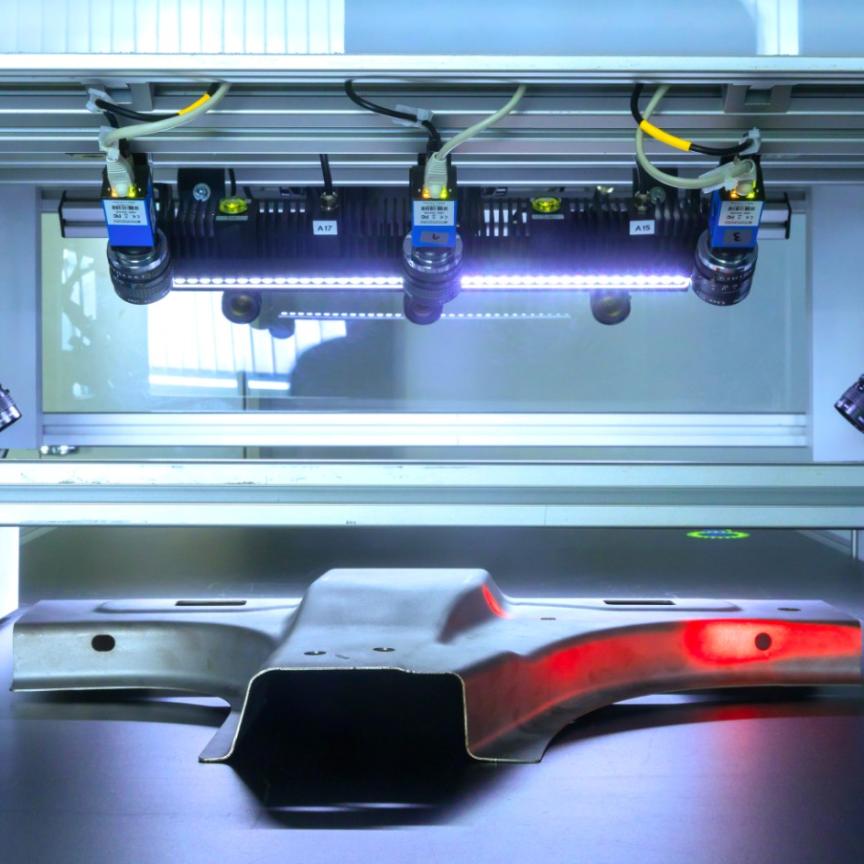While previous industrial revolutions were founded on technological breakthroughs such as the steam engine, electricity and computers, the imminent fourth industrial revolution – dubbed Industry 4.0 – is being driven by a concept that long-preceded them all: the creation and analysis of data.
The earliest examples of humans working with data were found on sticks and bones from 18,000BC, which Palaeolithic tribespeople would mark in order to keep track of trading activity and calculate how long food supplies would last. Fast forward 20,000 years and, while data is still being used for such fundamental purposes, it is also being used to power modern industry. Through obtaining, sharing and analysing data, processes across entire value chains are becoming networked and highly automated, with humans, machines, smart devices and software all working together – communicating via internal networks or the internet.
When it comes to collecting data, particularly for applications such as product inspection or directing robots and other equipment, machine vision is a key technology. Information can be extracted from vision data that can be used by manufacturers to improve production quality, both on the production line and to inform about the wider workings of the plant, such as for energy management. Ultimately, connected ‘smart’ factories are being established that are capable of manufacturing, predictive maintenance, inventory tracking, and other activities across the entire production network.
Setting the standard
For Industry 4.0 to work, cameras must be integrated at a digital level in a way that allows them to communicate and interact with other systems in industrial environments.
Defining machine vision systems on this more abstract level is what a group of 17 experts from European machine vision companies have been working on for the past three years. The work represents the first part of a new standard: OPC Machine Vision, which is being produced as a companion specification to Open Platform Communications Unified Architecture (OPC UA), a much larger international standardisation effort currently underway.
OPC UA is a vendor- and platform-independent machine-to-machine communication framework. The aim is to ease the implementation of Industry 4.0 by providing an interoperability standard for secure and reliable exchange of information in industry. OPC Machine Vision – which is being developed by the VDMA in collaboration with the G3 global standardisation co-operation for machine vision – will complement this by providing a common communication standard for vision-related components.
‘One part of the OPC Machine Vision specification will be a list of requirements that need to be included in the design of a vision system in order for it to comply with the standard,’ explained Karlheinz Hohm, vice president of R&D for industrial automation at Isra Vision and part of the OPC Machine Vision working group. ‘The result will be vision systems that are easier to integrate, which is both of benefit to the customer and the line builder. A line builder who has already integrated one type of vision system that complies with OPC Machine Vision will be able to integrate another type of vision system that also complies with the standard. In addition, for example, if a line builder has to design a PLC that interacts with a machine vision system, knowing how that system is represented on the digital level will make it simpler to integrate with the PLC.’
The OPC Machine Vision specification will also ensure that the data being produced by machine vision systems is structured and has meaning, which will increase the simplicity of communication between machines. ‘Some of this structured data will be provided ad hoc, while other data, such as diagnostic information, will be kept in lists, enabling features such as condition monitoring and predictive maintenance – other key aspects that will be seen in Industry 4.0,’ Hohm said.
He added that the easier integration offered by vision systems conforming to OPC Machine Vision, in addition to the decreasing size and cost of vision technology and the incorporation of processing power inside smart cameras, will ultimately enable machine vision to enter new markets and be used in more applications.
Michael Wandelt, managing director of Automation Technology, noted that ease of integration is important for manufacturing, as certain countries lack vision integrators. He said that, while in Europe there is an excellent platform for vision integrators, for the rest of the world, such as North or South America, there are almost none. ‘We only have one integrator partner over there… who is one of the very few vision integrators on the whole American market. A lot of countries are like this and don’t have a good platform of experienced integrators. Therefore, to push the success of machine vision, it’s really necessary to keep things simple. The advent of the smart camera will improve this dramatically.’
Automation Technology released its IRSX infrared smart camera earlier this year. The company has also developed an app to control the sensor and collect data remotely.
‘Through a simplified graphical user interface, OEMs and end users without programming or vision experience can pick and click apps they need for their application,’ Wandelt said. ‘The user just needs to load the different job concepts, and they are ready to go. These cameras are also able to automatically switch to a new job if, for example, you have a product change on your production line.’
Adapting to survive
While imaging systems are mainly used for quality inspection and parts identification, with the progressive implementation of Industry 4.0 the omnipresence of imaging systems will extend into fields such as warehouse and shipment management, and machine maintenance.
While Industry 4.0 will raise the business potential of machine vision, Marie-Charlotte Leclerc, product marketing manager at Teledyne Imaging, feels that the associated adoption of OPC Machine Vision could lead to camera manufacturers having to alter their strategies in order to survive.
She explained: ‘Camera manufacturers implement but also promote different interfaces. As the main machine vision camera brands often integrate the exact same mainstream sensors in their system, they have almost no way to differentiate in terms of electro-optical performances. Thus, interface becomes a crucial way to differentiate their offerings.
‘Nonetheless, in a factory of the future where every company would provide the same protocol, compliant with OPC UA specification, camera manufacturers will lose a serious driver of differentiation. This loss of differentiation, combined with ease of switching from one camera to another, will increase the negotiation power of distributors and worsen price pressure faced by camera manufacturers. Consequently, OPC Machine Vision will lead camera manufacturers to invest for their survival in improved, or at least differentiated, performances through differentiated image sensors, either by betting on different sensor manufacturers or by investing in custom designs, the last being the only way to ensure a complete differentiation on this highly saturated market.’
Camera manufacturers may not be required to make these investments immediately, as, while the transition to Industry 4.0 has already begun, its adoption by industry – plus the continued development and implementation of OPC Machine Vision – will be gradual.
‘In the next few years we will certainly see more and more evidence of information networks and changes in production as Industry 4.0 is implemented,’ said Hohm. ‘It won’t be the case that big manufacturers say: “OK tomorrow we are going to start getting rid of all of our equipment and will implement Industry 4.0 by this time next year.” It is more likely that they will instead start gradually adding sensors and interfaces to their existing devices, in order to connect them and start getting data out of them and into cloud servers. Also, for any new equipment or modifications, they will look to implement them with Industry 4.0 in mind.’
Regarding OPC Machine Vision, while part one has now been prepared and the development of part two is already underway, the standard will not only have to be implemented on a global scale, but also on IT production systems and the cloud, in addition to vision products, which will result in extensive uptake times.

Vitronic’s Carsten Born, another member of the working group for OPC Machine Vision, noted that because the field of industrial applications is a conservative market, the firm isn’t actually seeing a lot of market demand for OPC-based implementation currently. ‘But we are starting to see some changes,’ he noted. ‘For example, AIDA, an association of German car manufacturers, published information that OPC UA support will be a minimum requirement for all new production lines.’
He does, however, expect that there will be a rise in demand for OPC-based implementation in the coming years: ‘When OPC UA spreads, more and more companies – both the provider and customer side – will realise the benefits if all machinery uses the same basic language for communication. Maybe in 10 years we will reach a point where the universal language of industrial automation is widely accepted, so that there is no longer a discussion needed if or why someone should implement it.’
He added that it was an important goal of the development of OPC Machine Vision to offer a smooth transition path from the interfaces currently being used to OPC UA/Industry 4.0: ‘OPC Machine Vision is designed to be able to coexist with other interfaces controlling the same device. As we now have a description of the behaviour to be expected from a vision system [in part one]… it is now possible to create generic client software instead of having to rewrite this for each project or application, and for each brand of vision system you want to use.’
As OPC UA spreads, Vitronic expects that the time needed for engineering and implementation of machine vision applications will be reduced, not only on the vision side, but also on the side of automation systems and manufacturing execution systems.
Untapped potential
Although data exchange and analysis remain key factors in many industry sectors, a major challenge still lies in the efficient access and use of this data. The open communication network promised by Industry 4.0 and OPC Machine Vision will address this by providing an easy and standardised way to obtain, access and analyse data in production environments.
‘Machine vision is one of the key technologies for Industry 4.0 applications. There is hardly any other component in the production process that collects and analyses as much information as this one,’ Born concluded. ‘Industry 4.0 will enable us to release the full potential of machine vision, which currently is limited by communication issues. Combined with newer developments, such as deep learning, I’m sure we will see a lot of interesting new applications emerge. Accordingly, machine vision offers new ways to turn future-oriented concepts, such as the smart factory, into reality.’


